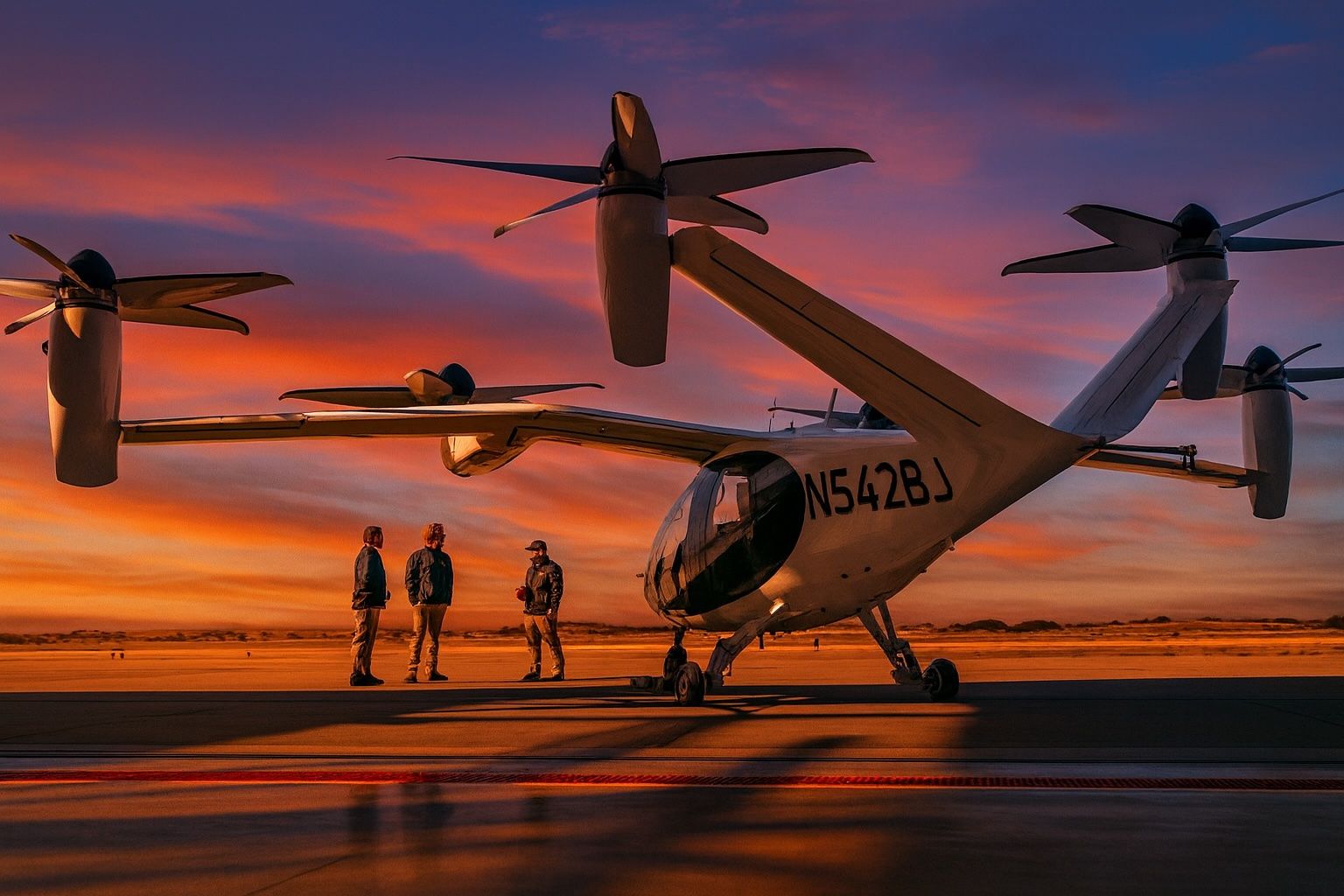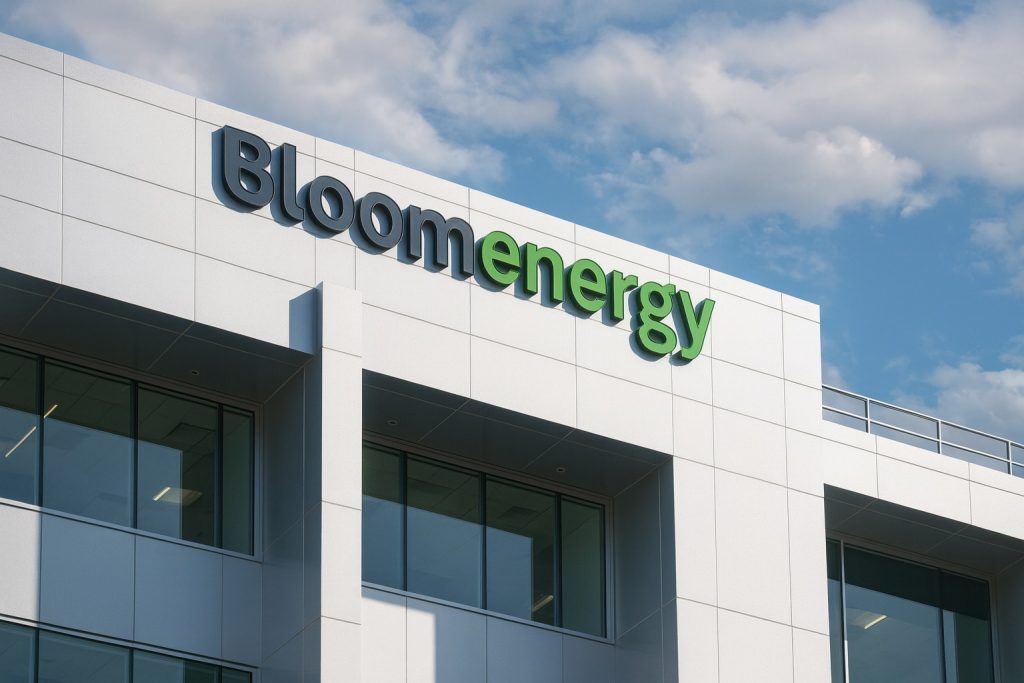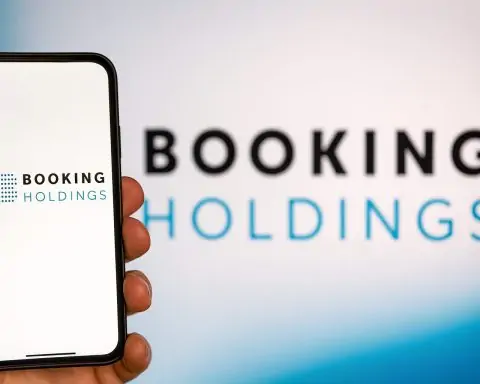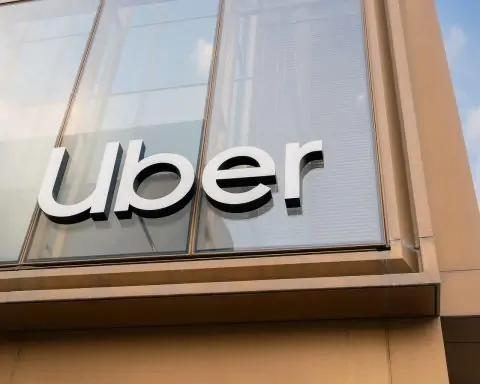- Stock Roller Coaster: Joby Aviation’s stock (NYSE: JOBY) closed around $15.60 on October 28, down ~4% for the day and roughly 3% lower than a week ago [1]. Despite this pullback, shares are still up nearly +97% year-to-date (and over +200% in the past 12 months) [2], vastly outperforming the market amid 2025’s electric air taxi hype.
- $500M Cash Grab: Earlier this month, Joby sold $500 million in new stock at $16.85/share, a surprise capital raise that triggered a 9–11% one-day plunge on dilution fears [3] [4]. Bulls, however, saw a silver lining – demand was strong. CNBC’s Josh Brown likened it to Tesla’s playbook, noting bears fretted about dilution “and then they would do a massive secondary and the stock would go up… What you have to understand is that the fact they can do a secondary is the bullish part… They snapped it up…that’s the bullish aspect” [5] [6], indicating investors eagerly gobbled up the offering.
- Analysts Flash Caution: Wall Street isn’t entirely on board the air-taxi hype. Most analysts rate Joby “Hold,” with an average 12-month price target ~$10.5 – well below the current price [7]. Price targets range from as low as $7 to about $17 [8]. The huge rally has overshot these targets, and experts cite the long road to commercialization (Joby has virtually no revenue yet and heavy losses) as reason for tempered expectations.
- Big Deals Fuel the Vision: Joby’s 2025 surge has been underpinned by headline-grabbing deals and tech progress. In August, Joby agreed to acquire Blade Air Mobility’s urban air shuttle business (for up to $125 M) and partnered with L3Harris to develop a military-grade eVTOL aircraft [9]. It also struck a UAE partnership to launch air taxi services in Dubai by 2027 and even conducted public demo flights in Japan with partner ANA – the first eVTOL showcased at a World Expo [10]. Just today, Joby announced a collaboration with NVIDIA to accelerate its autonomous flight systems, becoming the aviation launch partner for NVIDIA’s new IGX “Thor” AI platform [11] [12] – signaling a push into AI copilots for its future aircraft.
- eVTOL Race Heats Up: The flying taxi market is crowded and cut-throat. Archer Aviation (Joby’s U.S. rival) just beat out Joby in a bid to acquire 300 patents from Germany’s Lilium for ~$21 M [13] [14] after Lilium hit financial turbulence. Archer is also forging partnerships (e.g. Korean Air in Asia) and, like Joby, targeting FAA certification by 2025–26. Other players include Beta Technologies (Amazon-backed, filed for IPO in Sept 2025) and Eve Air Mobility (backed by Embraer, projecting a 30,000-aircraft eVTOL fleet by 2045) [15]. All are vying for first-mover advantage as governments jump in – the FAA’s new Advanced Air Mobility pilot program (launched Sept 2025) will even allow limited air taxi operations on select routes before full certification is achieved [16].
- Future Outlook – High Hopes vs. High Risk:Joby aims to certify its eVTOL by 2026 and start limited commercial services soon after [17]. It has nearly $1 billion in cash (bolstered by the recent stock sale) to fund final testing, manufacturing, and vertiport infrastructure. Industry forecasts are massive – the air mobility market could reach hundreds of billions in revenue over the next two decades [18] as urban “flying cars” potentially transform transportation. But serious challenges loom: no eVTOL has ever been certified by regulators, timelines could slip, and competition is fierce. Many see ventures like Joby as a “binary bet” – they’ll either revolutionize travel or struggle to deliver on lofty promises [19]. For now, investor enthusiasm remains cautiously optimistic. All eyes are on upcoming milestones – including Joby’s Q3 financial results on Nov. 5 [20] and progress updates from the FAA – to gauge whether this sky-high stock can sustain its altitude or if turbulence will grow as the dream of air taxis edges closer to reality.
A Wild Week for JOBY Stock
Joby Aviation’s stock price has been on a wild ride in recent days, reflecting both the sky-high optimism and the jitters surrounding this futuristic air-taxi company. On Tuesday, Oct. 28, Joby’s shares closed at $15.60, down about 4.3% for the day [21]. The dip caps off a volatile week: just last Monday (Oct. 20) the stock spiked 11% in a single day, then plunged a combined ~12% over the next two sessions [22]. Even with the recent pullback, Joby’s stock is still dramatically higher than where it began the year – up roughly 97% year-to-date as of late October [23]. Over the past year it has more than tripled in value, a staggering rise that underscores the eVTOL (electric vertical takeoff and landing) hype driving investor interest.
Such roller-coaster swings are becoming the norm for Joby. The company went public via SPAC in 2021 and spent years trading in the single digits as a pre-revenue startup. But in 2023–2025, a steady drumbeat of progress – from test flights to strategic partnerships – has sent the stock soaring. By early October 2025, shares hit all-time highs near $19–$20 [24], a level few analysts expected. This rapid ascent, however, means expectations are sky-high. Any hint of bad news or delays tends to spark quick selloffs, as seen this week. “The rapid rise also means the stock carries high expectations – any delays or setbacks… could introduce volatility,” one analysis noted [25]. In short, Joby’s valuation is now baking in near-perfection, leaving little room for error as the company races to launch its air taxi service.
Surprise Stock Offering Shakes Investors
One catalyst for Joby’s recent turbulence was its decision to raise fresh capital by issuing new shares – a move that caught the market off guard. On Oct. 7, Joby announced a major underwritten public offering of 30.5 million shares at $16.85 each, equating to $500 million in gross proceeds [26]. The offering price represented about a 10–11% discount to the prior day’s close, and investors reacted swiftly to the dilution: Joby’s stock plunged roughly 9–11% in after-hours and next-day trading on the news [27].
The dilutive share sale initially spooked shareholders – after all, issuing 30 million new shares increased Joby’s share count by nearly 15–20% [28]. However, the company argued the cash infusion was necessary to fund its ambitious plans: management said the ~$500 million will go toward FAA certification testing, ramping up aircraft manufacturing, and launching commercial operations at its vertiports (including those acquired from Blade) [29]. Essentially, Joby is refueling its tank for the final stretch to get its electric air taxis off the ground.
Not everyone saw the stock offering as a negative. In fact, the ability to raise a half-billion dollars at a favorable price was viewed by some experts as a vote of confidence. Josh Brown, CEO of Ritholtz Wealth Management, remains bullish on Joby and likened the situation to early Tesla: skeptics fretted about dilution, “and then they would do a massive secondary and the stock would go up… What you have to understand with these companies… is that the fact that they can do a secondary is the bullish part,” Brown said on CNBC [30]. The new shares, priced at $16.85, were snapped up “like it was an amuse-bouche,” he quipped, pointing to the strong appetite to invest in the “low altitude economy” of air taxis [31]. In Brown’s view, raising ample capital now is “great news” – it ensures Joby has the money to build out its vertiports (after the Blade acquisition) and continue developing its S4 aircraft, rather than risking a cash crunch later [32].
Still, the offering highlights a core tension in Joby’s story: the company is burning cash (it expects over $500 million in cash burn for 2025 alone [33]) and has no meaningful revenue yet (just tens of thousands of dollars from small contracts). Tapping equity markets for funding is essential to keep the dream alive, but it dilutes current investors and underscores how high-risk, high-reward this venture remains. As one commentator put it, Joby “took advantage of the speculators with a stock sale” at lofty prices, banking much-needed funding at the cost of some near-term turbulence for the stock [34]. The bet is that this short-term pain will pay off in long-term gains if Joby executes on its plan.
Major Partnerships and Milestones in 2025
Fueling the exuberance around Joby are the company’s notable deals and milestones achieved over the past year. These strategic moves have lent credibility to Joby’s vision and expanded its capabilities beyond just building aircraft – and they help explain why investors have bid the stock up so sharply.
One of the biggest moves was securing infrastructure and customers ahead of launch. In August, Joby announced it will acquire Blade Air Mobility’s passenger business for up to $125 million [35]. Blade operates helicopter and seaplane charter services in cities like New York and Los Angeles, with a network of rooftop heliports/vertiports and an established base of affluent travelers. By buying Blade’s urban terminals and integrating its services, Joby instantly gains vertiport real estate in key cities and access to Blade’s ~50,000 annual passengers, who could be early adopters of eVTOL rides [36]. Analysts hailed the Blade deal as “massive de-risking” of Joby’s rollout – instead of building an air taxi network from scratch, Joby can plug into Blade’s existing routes and even link into Uber’s app by 2026 for seamless rider booking [37]. In short, Blade gives Joby a running start when its aircraft are ready to fly.
Joby also forged a significant defense partnership in 2025. It teamed up with L3Harris Technologies, a major aerospace and defense contractor, to co-develop a military version of Joby’s eVTOL [38]. This hybrid-electric aircraft (adding a small gas turbine for range) is aimed at U.S. military applications like surveillance and logistics. L3Harris called Joby’s tech an “urgently-required innovation” for defense [39], and flight tests of a prototype are expected by late 2025 [40]. For Joby, the tie-up opens a new revenue stream (government/defense) that doesn’t depend on consumer air taxi adoption, and it validates the robustness of Joby’s technology in demanding use cases. Importantly, defense projects often come with funding – essentially non-dilutive capital – to develop cutting-edge aircraft. This collaboration showcases Joby’s strategy of leveraging partnerships to extend its reach, be it into military markets or, as with Blade, into ground infrastructure and customer pools.
On the global front, Joby has been expanding its footprint. In late September, the company inked a deal in the United Arab Emirates to launch air taxi services by 2027 in collaboration with local partners (Skyports and Ras Al Khaimah’s transport authority) [41]. The Middle East, with its supportive regulators and appetite for futuristic transport, is seen as a prime market for early eVTOL deployments. Likewise, Joby has a deep partnership in Japan with airline ANA. In October, a Joby prototype emblazoned in ANA’s livery wowed crowds at the Expo 2025 World’s Fair in Osaka, completing the first-ever public eVTOL demonstration flights at a World Expo [42]. The showcase signaled Japan’s intent to be a leader in advanced air mobility – and gave the public a tangible glimpse of what an air taxi service might look like. Japanese regulators (JCAB) are working closely with Joby and ANA to craft the rules needed to operate air taxis in cities like Tokyo in the coming years [43]. These global demonstrations and alliances are critical: they position Joby as the frontrunner in a race where gaining government buy-in and public acceptance might be just as important as the technology itself.
Even on the technology side, Joby continues to make waves. On Oct. 28, the company announced a new partnership with NVIDIA, the semiconductor and AI computing giant, to accelerate Joby’s efforts in autonomous flight. NVIDIA selected Joby as the launch partner for its cutting-edge “IGX Thor” AI platform – essentially a powerful onboard computer designed for safety-critical autonomous machines [44]. By integrating NVIDIA’s system, Joby aims to advance its “Superpilot” autonomous flight software for future use in both military and eventually civilian applications [45] [46]. In plain terms, Joby is preparing for a future where its air taxis could have significant autonomous capabilities (though likely still with a human pilot as backup for the foreseeable future). This collaboration highlights how Joby is not standing still; even as it works to certify its piloted aircraft, it’s investing in next-generation tech like AI to maintain a competitive edge long-term. It’s worth noting that some rivals, like Wisk (backed by Boeing) and EHang in China, are pursuing fully autonomous air taxis – but Joby’s approach has been incremental, focusing on piloted operations first while laying groundwork for autonomy in parallel [47].
The Air Taxi Industry: Competitors, Consolidation, and Support
Joby may be in the spotlight, but it’s far from alone in the race to make flying taxis a reality. The eVTOL industry (electric vertical takeoff and landing aircraft) has become a hotbed of activity in 2025, with multiple startups vying for funding, partnerships, and regulatory wins. This past month saw some dramatic developments among Joby’s rivals – including a bit of industry consolidation that underscores both the promise and peril of the sector.
In mid-October, Archer Aviation (NYSE: ACHR), a California-based eVTOL competitor, announced it won a bidding war to acquire the intellectual property of Lilium GmbH, a once high-flying German air-taxi startup. Archer is paying roughly €18 million (~$21 million) for Lilium’s portfolio of 300 advanced air mobility patents [48]. Lilium, founded in 2015, had spent over $1.5 billion developing a unique electric jet-powered aircraft but filed for insolvency in late 2024 amid financial struggles [49]. Archer swooping in to buy its patents (and reportedly, Joby was outbid in the process) shows that not every eVTOL contender will survive – and the ones with stronger balance sheets can capitalize on the failures of others. Archer’s CEO lauded Lilium’s technology and indicated the patents (spanning battery systems, propulsion, and flight control designs) will bolster Archer’s own development efforts. News of the deal sent Archer’s stock up ~8% that day [50], as investors saw it as a savvy pickup of valuable tech on the cheap. For Joby, the takeaway is that the competition is fierce and at times cut-throat: rivals are looking to leapfrog by acquiring each other’s tech and talent. It also highlights a reality check – Lilium’s downfall illustrates how challenging and capital-intensive this field is, and serves as a cautionary tale for companies like Joby and Archer to carefully manage cash burn on the long road to commercialization.
Archer hasn’t just been bargain-hunting the remains of competitors; it’s also making its own strategic partnerships. In late October, Archer announced a deal with Korean Air to collaborate on introducing eVTOL air taxis in South Korea in the coming years [51]. It also was named an exclusive air taxi partner for the 2026 World Cup in Los Angeles, as that city gears up for advanced urban mobility ahead of major events [52]. Meanwhile, Archer’s first model, the Midnight (a 4-passenger eVTOL), has logged 500+ test flights and is targeting FAA certification around late 2025 to 2026, similar to Joby’s timeline [53].
Beyond Archer, other players include Beta Technologies, a Vermont-based hybrid-electric aircraft maker that has backing from Amazon and UPS. Beta made news by filing for an IPO in September 2025 and securing a $300 million strategic investment from General Electric as part of that process [54] [55]. There’s also Eve Air Mobility, backed by Brazilian airplane manufacturer Embraer, which is taking a more conservative timeline (service around 2026–2027) but projects a huge market – Eve estimates a potential global fleet of 30,000 air taxis by 2045 and passenger revenues around $250–$300 billion by the mid-2040s [56] [57]. European contender Volocopter is aiming to launch air taxi services during the Paris 2024 Olympics, highlighting that this is a worldwide race. And in China, EHang is pursuing an autonomous two-seater drone taxi and has already started pilot operations in a few Chinese cities.
Amid this flurry, regulators and governments are actually providing tailwinds. In the U.S., Washington has thrown support behind advanced air mobility (AAM): in late 2025, the FAA rolled out an AAM Pilot Program that will allow eVTOL companies to operate limited routes and services as a trial before full certification [58]. This program effectively lets early entrants like Joby demonstrate commercial operations (on a small scale) perhaps as soon as 2024 or 2025, even if their aircraft are still in a provisional certification phase. Additionally, a recent Executive Order from the White House directed federal agencies to coordinate on expediting air taxi integration, recognizing it as a strategic industry [59]. Overseas, countries like Japan and the UAE are actively courting eVTOL developers, streamlining regulations and offering government partnership (as seen with Joby’s Expo flights in Japan and its UAE agreement) [60]. The global race has an aspect of government competition too – cities and nations want to claim the first flying taxi networks, both for the economic boost and the futuristic prestige.
For investors in Joby, these industry currents cut both ways. On one hand, the pie is likely huge – urban air mobility could eventually be a transformative new mode of transportation, and early leaders might enjoy network effects and brand recognition that yield outsized market share. The hundreds of billions in projected market size suggest there’s room for multiple winners if the technology delivers [61]. On the other hand, the flurry of competitor activity means execution is paramount. Joby will need to maintain its lead through technological superiority, regulatory savvy, and deep pockets – all while others are nipping at its heels. The collapse of Lilium underscores that even $1 billion in R&D spending guarantees nothing if the business model or fundraising dries up. In short, the flying car race is both an opportunity and a fight for survival. Joby appears to be in pole position for now, but it will have to continuously innovate and execute to stay there as the eVTOL era approaches.
Can Joby Justify the Hype? Outlook and Forecasts
With its stock price still riding high compared to a year ago and a fresh war chest of cash, Joby Aviation now faces the crucial task of execution – turning its ambitious vision into a viable commercial service. The next 12–24 months will be pivotal in determining whether Joby’s lofty valuation is warranted, or whether the company hits speed bumps that temper the exuberance.
Analyst sentiment at present is mixed leaning cautious. The consensus on Wall Street is that patience is required. According to MarketBeat data, Joby carries a consensus “Hold” rating and a median price target around $10–$11 [62]. In other words, many analysts believe the stock – currently in the mid-teens – may be ahead of itself. Price targets from firms like JPMorgan (around $7) reflect skepticism about the pace of profitability, while a few optimistic targets (Canaccord Genuity at $16–$17) assume Joby will execute near-flawlessly [63]. The caution comes down to fundamentals: Joby remains pre-revenue (it reported virtually no sales in Q2 2025 and expects minimal revenue until it launches rides) [64], and the company will likely continue running at a loss for several years as it builds out manufacturing and support operations. There’s also uncertainty on how quickly the public will adopt air taxis and what price point can drive mass usage – questions that can’t be answered until services actually begin.
That said, market forecasts for the sector’s future are undeniably rosy. Joby and its peers are chasing what could be a massive market a decade or two out. By some estimates, the global urban air mobility market could top $100 billion in annual revenue by 2040 [65] (and even more by 2045, per some aviation studies). This includes not just passenger taxis but also cargo, medical evacuation, and regional air services – all of which eVTOLs could potentially serve. If Joby can capture even a slice of that, its current ~$15 billion market cap might someday look justified. Investors bullish on Joby essentially see it as the frontrunner in a transformative industry, analogous to being an early leader in electric cars or commercial space flight. They point to Joby’s strong partnerships and backing (Toyota, for example, poured ~$500 million into Joby and is its largest outside shareholder [66]) and its head start in testing. Joby is already about 70% through the FAA certification process for its aircraft as of Q3 2025 [67] – progress that suggests it could be among the first (if not the first) to earn approval in the U.S. Within the next year, the company aims to clear remaining FAA stages (G3 and G4) and build conforming production models of its S4 aircraft. By 2026, Joby hopes to launch initial commercial air taxi services in select cities, potentially starting with pilot programs or shuttles to airports.
The big question: will reality match the hype? Bulls like Josh Brown argue that Joby’s moves – raising plenty of cash now, locking in vertiports and partners, impressing regulators – put it in an enviable position. Once operational, Joby could enjoy a “winner-take-most” dynamic if customers flock to the first reliable air taxi option. Additionally, Joby’s model of both operating its own fleets and selling its aircraft to other partners (like foreign airlines or defense customers) could diversify revenue. Morgan Stanley in the past dubbed urban air mobility a “flying car revolution” with multi-trillion-dollar implications long term, comparing its disruptive potential to the advent of cars or airplanes in the 20th century.
On the flip side, risks are plentiful. The regulatory timeline is uncertain – the FAA has never certified an eVTOL, and despite promising progress, unforeseen hurdles could appear (safety findings, supply chain issues, etc.). Any delay in certification or a mishap in testing could severely set back not just Joby’s timeline but also investor confidence. Competition, as detailed, means even if Joby is first, it won’t be alone for long; rivals could undercut on price or launch in markets Joby isn’t covering. And from a financial perspective, Joby’s valuation assumes a lot of future success. If broader market sentiment turns risk-off (for instance, if interest rates rise or if there’s a recession), high-flying pre-profit stocks like JOBY can be hit hard. Some skeptics have called the air taxi craze a bubble, noting that prototypes have wowed the public for years but paying passengers are still waiting. As CNBC’s Jim Cramer cautioned recently, “I’m concerned about Joby… it’s an exciting concept, but the stock’s market cap reflects decades of growth that are far from guaranteed” [68].
For now, Joby’s management is preaching steady progress and transparency. The company’s next big update will come with its Q3 2025 earnings report on November 5 [69]. While revenue numbers won’t be the focus (they’ll be minimal), investors will be keen to hear guidance on certification milestones, cash burn, and perhaps updated timelines for launching service. Any positive surprise – say, faster testing results or new partnerships (maybe more airlines or ride-sharing integrations) – could bolster the bull case. Conversely, any sign of delay or costs overrunning could validate the bears.
In summary, Joby Aviation stands at an inflection point. The stock’s dramatic rise in 2025 reflects a broader excitement that flying taxis are no longer just science fiction – real aircraft are flying, regulators are engaged, and commercial service is on the horizon. Joby has positioned itself as a leader of this pack with savvy deals and technological progress. Now comes the hard part: delivering. The company must prove that it can transition from a prototype-maker to a safe, efficient commercial operator with paying customers. If it succeeds, today’s valuation could be merely the launching pad, and Joby might one day be mentioned in the same breath as other transport revolutionaries. If it stumbles, however, the stock’s altitude could rapidly drop back to earth, as has happened to others before. As one industry expert put it, eVTOL ventures are a “binary bet” – they’ll either transform transportation or struggle to get off the ground [70]. After this year’s exhilarating ascent, 2026 will be the true test of whether Joby Aviation can soar or if turbulence will stall its flight path.
Sources: Joby press releases and investor reports; Reuters [71] [72] [73]; TechStock² (ts2.tech) analysis [74] [75] [76]; InsiderMonkey [77] [78]; Investing.com [79]; MarketBeat [80]; company and industry data.
References
1. www.investing.com, 2. www.marketbeat.com, 3. www.reuters.com, 4. ts2.tech, 5. www.insidermonkey.com, 6. www.insidermonkey.com, 7. ts2.tech, 8. ts2.tech, 9. ts2.tech, 10. ts2.tech, 11. ir.jobyaviation.com, 12. ir.jobyaviation.com, 13. www.reuters.com, 14. www.reuters.com, 15. ts2.tech, 16. ts2.tech, 17. ts2.tech, 18. ts2.tech, 19. ts2.tech, 20. ts2.tech, 21. www.investing.com, 22. www.investing.com, 23. www.marketbeat.com, 24. ts2.tech, 25. ts2.tech, 26. ts2.tech, 27. www.reuters.com, 28. ts2.tech, 29. www.reuters.com, 30. www.insidermonkey.com, 31. www.insidermonkey.com, 32. www.insidermonkey.com, 33. ts2.tech, 34. ts2.tech, 35. ts2.tech, 36. ts2.tech, 37. ts2.tech, 38. ts2.tech, 39. ts2.tech, 40. ts2.tech, 41. ts2.tech, 42. ts2.tech, 43. ts2.tech, 44. ir.jobyaviation.com, 45. ir.jobyaviation.com, 46. ir.jobyaviation.com, 47. ts2.tech, 48. www.reuters.com, 49. www.reuters.com, 50. www.reuters.com, 51. investors.archer.com, 52. www.investors.archer.com, 53. 247wallst.com, 54. ts2.tech, 55. ts2.tech, 56. ts2.tech, 57. ts2.tech, 58. ts2.tech, 59. www.reuters.com, 60. ts2.tech, 61. ts2.tech, 62. ts2.tech, 63. ts2.tech, 64. ts2.tech, 65. ts2.tech, 66. ts2.tech, 67. ts2.tech, 68. www.insidermonkey.com, 69. ts2.tech, 70. ts2.tech, 71. www.reuters.com, 72. www.reuters.com, 73. www.reuters.com, 74. ts2.tech, 75. ts2.tech, 76. ts2.tech, 77. www.insidermonkey.com, 78. www.insidermonkey.com, 79. www.investing.com, 80. www.marketbeat.com










